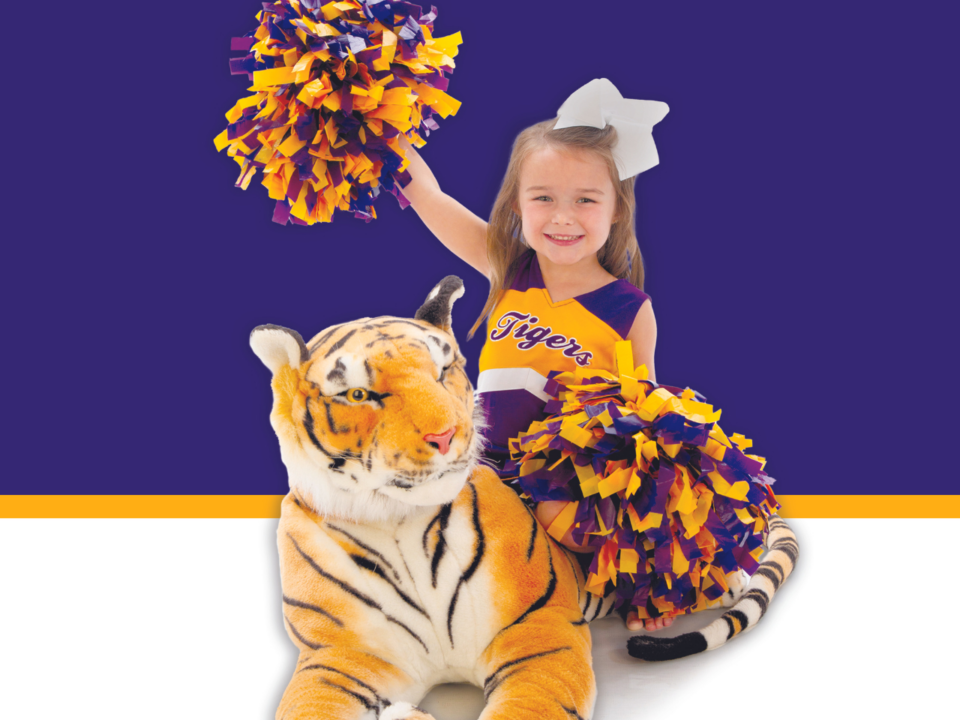
The Sport and Art of Cheerleading
Cheerleading tends to be written off as a female, after-school activity that some don’t even consider a sport. Yet, tumbling, stunting, pyramids, and other moves commonly seen in cheer routines take mental and physical strength. Cheerleading is not just putting on a colorful, bedazzled outfit–there is hard work and team dynamics that are necessary to safely perform these acrobatic stunts. Here are some of the top things you need to know about cheer.
TEAM BONDING
For all sports, team bonding is an essential element in order to have a uniform and successful team where each player can count on their teammates and coach. It is vital for a cheer team to have great communication and to trust one another, not just because it makes the routines run smoothly but because it keeps the cheerleaders safe.
The owner and director of Baton Rouge Cheer Academy, Shawn Lagarde, does team-building activities with the students so they can bond, learn about each other, and ultimately trust everyone on the team.
“With them being able to work together and do something as a group, it builds that bond and trust between the athletes. It’s very important that they do that,” Lagarde says. “They want to be able to trust who they are working with because they’re doing stunts and tricks in the air. They have to feel comfortable with the person that’s throwing them in the air.”
HEALTH AND CONCUSSIONS
Even with cheer teams that can count on every player, injuries still can occur. Safety is another essential element of this dynamic and challenging sport.
According to a study published by The American Academy of Pediatrics, football was the leading sport of concussions during practice in 2019, but cheerleading was second and beat out several sports, including basketball, hockey, and soccer.
Lagarde says it’s just like a contact sport; there’s safety training involved for coaches and cheerleaders. Coaches at Baton Rouge Cheer Academy focus on teaching athletes the correct way to “spot” and measures they can take to prevent concussions and other injuries.
More than half of the injuries seen in cheerleading are sprains and strains, but according to Athletico Physical Therapy, concussions account for 31.1 percent of injuries.
“You may be thinking this high rate of concussions would be from cheerleaders falling and landing on their heads. However, the cheerleading position that suffers the most concussions are the bases, and athletes who support the flyers in the air by holding them up and catching them,” states Athletico Physical Therapy.
SKILLS LEARNED
“Research shows that participating in youth sports can lead to immediate and long-term benefits for youth, their families, and communities,” states the President’s Council on Sports, Fitness and Nutrition Science Board.
Children that participate in sports not only better their physical health but also improve their mental, emotional, and social well-being.
“Cheerleaders are some of the most intense, driven, and passionate athletes in the world,” states the Cheer Information Center. “The variety of elements of the sport, mixed with the extremely competitive nature of the sport, produces tough, strong- willed athletes.”
Cheerleading especially teaches athletes time management. During a routine, cheerleaders have a set amount of time, and everything is done to eight counts. This teaches students and children time management skills by counting throughout a routine. Depending on how competitive of a team your child’s on, the time commitment to the sport helps athletes learn to balance their social life, academics, and team responsibilities.
COMMITMENT
“I will definitely say in the beginning, the level of commitment may not be as high because they’re younger and parents are exploring different avenues for their children to find themselves,” Lagarde says. “With competitive cheerleading, it requires a lot of commitment and dedication.”
Lagarde describes cheerleading as a developmental sport where athletes with no experience will slowly learn the basics of cheerleading. Many athletes that are new to cheer want to learn exciting and thrilling moves right away, like a backhand spring, but it’s crucial for them to learn the basics first.
“When an athlete comes in with no experience. We train them as beginners, and then they grow in the sport,” Lagarde says. “It allows kids to grow and not to be rushed to learn certain skills so fast.”
On the other hand, competitive cheerleading is a lot more of a commitment and tends to be a year-round sport. Competitive cheer teams range in age, but most teams don’t start going competitive until age 13. The commitment and cost changes once athletes and families choose to compete competitively.
SPORT FOR EVERYONE
Despite some beliefs, cheerleading is not just a women’s sport. There are several benefits to having a coed cheer squad, one being that males tend to be stronger than females, and as cheerleaders, they make great bases.
“The good thing about cheer is it’s so versatile that they have all-girl and coed teams. It allows those boys to be a part of the team. And, of course, boys are bigger, and they’re stronger,” Lagarde says. “They’re going to enhance any routine they’re in because they’re able to help with the stunting.”
Yet, there is still this stigmatism surrounding cheer that continues to discourage male athletes from joining.
“If people would not be so close-minded about the sport itself and just realize that anybody who has the love for those things–the tumbling, dancing, stunting–they can enjoy cheer,” Lagarde says. “At BRCA, it’s an open-door policy for girls, boys, whoever wants to come in and learn the art in the sport of cheer.”





